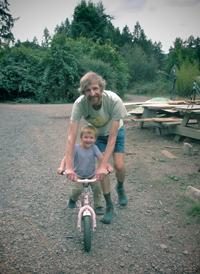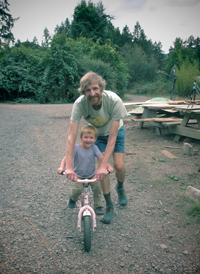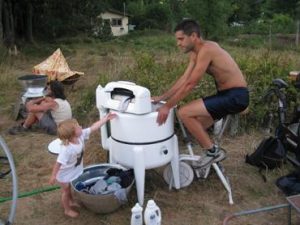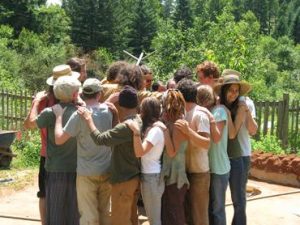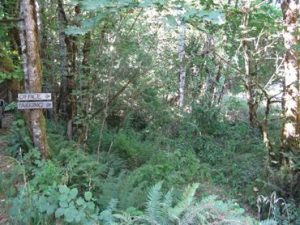A Beginning at the End of the Road
When I arrived at my first place-based intentional community, tucked away in the Oregon woods, I wondered if I could feel good ethically about all the compromises I’d be making by living there. In the previous couple years I’d been living mostly in a tent, using just a small solar panel for electricity in my dwelling, cooking only with sunlight, getting around just by foot or bike, eating no animal products or packaged foods, trying to minimize my ecological footprint (including consumption of nonrenewable energy) in all the ways I could think of.
By contrast, this place—named End of the Road, although it turned out to be just the beginning of the road for me in the intentional community world—was, for one, hooked up to the electrical grid. True, our electric bill (for a group that ranged from four to 12 members at a time) was always less than $10 a month. We didn’t have a refrigerator (substituting a “draft box” on the back porch instead), but we did have a freezer, which contained, among other indulgences, packaged, nonorganic, milk- and sugar-laden ice cream. Instead of tolerating the ambient temperatures, people here also built fires for warmth (burning trees and adding to pollution and global warming), and also cooked with wood and even propane. A few of them had cars, which they occasionally drove to town. There was even a computer in the office, which some residents used occasionally.
The difficulties in adapting to this collective pact with various civilizational devils were obvious. It was far from ideal for an ardent eco-liver in his early-mid-20s (this was the mid-late 1980s, in an environmental landscape reeling from the policies of Ronald Reagan and James Watt), but it had to do, because it was the place I had chosen to pursue another goal: grow as much of the group’s own food as possible by hand, to save all the energy that would otherwise go into growing and transporting the food we’d buy.
I did manage to stay fairly true to my ideals. For the next two years, despite the fact that I had a room available to me, I slept outside, getting my comfort and entertainment from the natural environment instead of pumping it into an indoor space. I don’t think I ever actually lit a fire—I always let someone else give in to that weakness. I avoided the ice cream, built a solar cooker, made copious use of the hayboxes (retained-heat cookers) that I learned about there, never obtained a car and usually didn’t even step into one, continued to eat a purer-than-thou, unpackaged diet, tried to purchase only “used” (not new) on those rare occasions when I did find myself truly in need of something material, and put together the group’s newsletter on a typewriter instead of the computer.
Most visitors to this place were coming from the opposite direction in terms of lifestyle. For them, our way of life seemed hard-core, austere, even severe—aligned with ecological ideals to a fault, often at the expense of comforts to which they were attached. It did fall on the hard-core end of the eco-living spectrum among intentional communities which were open to the public (we offered internships, courses in sustainable living skills, and other opportunities to get involved), but from my perspective it was still a study in compromise, especially compared with how native people had lived in this region for thousands of years preceding the European invasion (of which we were the latest representatives).
We were trying to undo the harm caused by that conquest of the land in whatever ways we could, but it was a long path to that goal, and we knew we had just started on it. We were forever hobbled by our upbringings in western consumer culture, but we hoped to explore and model a different way of doing things. This different way would—must—become the “new normal” if our species were to survive. Eventually, our own bad habits (like that ice cream in the freezer, once we were sufficiently unplugged) would melt away, replaced by the richness of the culture we’d helped create.
The Wisdom of Babes
I’d been following this hard-core path for a while, spanning a couple years with a traveling environmental education school (see Power and Disempowerment on the Ecobus, issue #148), a year-and-a-half on a Native American reservation, and close to a year immersing myself in solar cooker design and then ecological horticulture, all while living outdoors. Even before the “rebellion” that took me from an east coast suburban liberal arts education to a lifestyle that aspired to out-earthfirst EarthFirst!, I had reduced my nonrenewable energy consumption through an aversion to spending money, a distaste for automobiles and love of foot-powered transport, an ongoing boycott of “canned” entertainment, a dedication to eating low on the food chain, and other strategies. Some of these choices were intellectually and morally driven, stemming from my growing awareness of human impacts on the planet. But some were simply a return to the sensibilities that I’d had as a child before I had any awareness of larger ecological issues or knew much about any world outside my own life and family.
As a young child I was afraid of anything that made a loud noise. Someone else had to flush the toilet for me. Vacuum cleaners caused me great distress. Getting into a car often precipitated crying. Left to my own devices, I would have designed a world without any of those things—and it would have been a world that consumed a lot less (nonrenewable) energy. Gradually I learned to be a “big boy,” one who flushed his own toilet, vacuumed his own room, cooperated by getting into the car, and even eventually agreed to get a driver’s license (while vowing to use it rarely if ever). I hardened myself to the way modern life is, for survival if nothing else. Only crybabies, I concluded, can’t handle the ruckus and commotion that the fossil fuel age has brought—and I didn’t want to be a crybaby.
But I wonder:
Did my infantile self know something that our adult selves are just beginning to grasp? Is it possible that using so much energy, and living amidst all the noise created by this energy consumption, is actually bad for our own well-being, not to mention the planet’s? Could our energy habits actually be in direct conflict with the biological, spiritual, emotional, and social health of the human animal?
It’s Not Easy Being Green
As I mentioned, my arrival at End of the Road involved a lot of apparent compromise. But it was only the beginning of what was either a slippery slide back into being an overconsumer or, looked at another way, a growth out of “energy fundamentalism” into a broader understanding of energy and how it works.
Gradually I realized that even though I couldn’t think of myself as being so pure anymore, my participation at End of the Road did probably have a net positive impact on the planet, energy-wise. While not divorced from our culture’s bad habits entirely, our group (even when there were up to a dozen of us) likely had a smaller ecological footprint all combined than even just a single typical mainstream American had. And we set out not only to “walk the talk” but to “talk the walk” and expose others directly to some of our practices. Our small nonprofit organization, Aprovecho, was the point from which several influential technologies spread.
Hayboxes, an old technology which can also be constructed with modern materials, result in cooking fuel savings of 70 percent or more. Aprovecho’s brochures, newsletters, workshops, and living demonstrations ultimately seeded hayboxes in many places around the world. (I did my small part by later building hayboxes at a few other intentional communities and writing an article touting their benefits in Communities #115.) Rocket stoves, highly efficient low-mass stoves with an insulated combustion chamber, able to be constructed from a wide variety of easily available or local materials, originated at Aprovecho, and have spread worldwide (see www.aprovecho.org, www.aprovecho.net).
An ardent advocate of solar cooking, I encountered a mixture of resistance and appreciation as I tried to introduce it at End of the Road and elsewhere. I discovered that others were not necessarily as willing as I to make sacrifices in the interests of cooking with “zero fuel”—inconveniences such as starting the cooking process earlier than they otherwise would, returning to refocus the cooker every few hours, risking uncooked food on potentially cloudy days, etc. The impulse to make a statement and be pure bumped up against the reality that self-nurturance sometimes requires being gentle with oneself and others, using easily-available resources on hand even if they’re not perfect, taking one’s own reserves of time and energy into account when making choices.
Ultimately, I left End of the Road and Aprovecho for significantly less hard-core situations, as I realized that no amount of energy fundamentalism could substitute for the renewable energy of human connection.
Less Purity, More Renewal
My community-living path took me to varied situations, and in most of them our energy-consumption habits were significantly closer to the American standard than I’d experienced at the end of Hazelton Road. Yet they were still a far cry from the mainstream. Every group I lived with valued energy consciousness, and our per-capita consumption was still well below average as a result of resource sharing, simpler living, ecological values, and a striving for responsible global citizenship.
I often tried to cling to the more extreme, “pure” practices in my personal living space, but found I had to make peace with living with electric heat (for example) in some common spaces, along with refrigeration, computer servers that stayed on all day, and other features of modern life that I could rationalize only through the fact that they were shared among many people, diluting their impact.
But evolving in me simultaneously I discovered a much greater appreciation of a different kind of energy: the energy of love, warmth, and light that human beings themselves can generate for each other, regardless of whether they are on-grid or off-grid. This energy ultimately drew me to the community at which I’ve stayed the longest (totaling more than a decade-and-a-half now).
When I joined it, this community hosted intensive personal growth workshops and held weekly well-being meetings in which members practiced the skills and awareness cultivated by those workshops. We consciously worked on creating a culture in which openness, honesty, vulnerability, acceptance, self-acceptance, letting go of attachments, and love could set the tone of our interactions. When we dedicated ourselves to these intentions, and prioritized healthy communication and connection in our relationships, the energy we derived from this culture was palpable. In fact, the culture seemed to take on a life of its own, and even became our “default” mode; with our collective energy and daily practice behind it, it brought us along even in times of resistance, and became infectious even with visitors and short-term program participants.
It challenged us to see beyond a tendency toward judgment and imagined separation. It helped me realize that setting myself apart in a pure world of only “renewable energy” (or none at all) was not only impossible, but based on a false set of assumptions about the world. Without adequate and genuine human connection, the solo renewable energy pioneer may not actually create a model of a sustainable future. In fact, he or she may end up desperately accumulating renewable energy toys and gizmos, actually consuming more resources and energy than someone who’s learned that the way to a light footprint is to learn to dance with others. This second approach may involve give-and-take, and compromises of black-and-white worldviews and positions, but it will likely ultimately result in more sharing and more resilience. It reduces the perceived need for more under-inhabited renewable energy mansions or fortresses, and increases the number of people who are happy sleeping on one another’s floors, sharing one another’s kitchens, and dealing with challenges together.
Solar Power and Soul
Part way through my renewable energy journey, a friend helped me assemble a photovoltaic system to power lights and a cassette player in my otherwise unelectrified cabin. For at least a dozen years, this served as the main or only source of electricity in my living space. Its initial installation cost less than running an electric line to the cabin would have cost, and even when I moved it to another location where grid power was available, I still valued not only the electricity it gave me but the lessons it taught me. As my experiences with solar cooking had done, it helped instill in me a much more acute awareness of weather patterns, and also showed me my own patterns of energy usage. I never flipped or left a switch “on” unless I had a good reason for using those electrons. Maintaining my own power system, I was constantly aware of the reality of limitations, of the need for conscious use of the earth’s “goods.” I could not live in a fantasy of limitlessness (at least not physical limitlessness)—if I acted as if the power in my system would never run out, it would run out.
Using my own off-grid photovoltaic system, like cooking with the sun, became a way of attuning myself not only to ecological realities, but also ultimately to spiritual realities. It felt like a form of prayer. It didn’t always make logical sense—and since for most of that time I also had access to grid power (and used it in our common spaces), it wasn’t even a statement of purity or a hard-core activist stance. But it did help me feel more grounded, and was a step back from the less-mindful energy consumption so easy to fall into without deliberate measures to counteract it.
When, overwhelmed by changes at my home community and convinced that my own path had diverged from it, I set off for what turned out to be a year away, I at first tried to ignore how important my semi-off-grid lifestyle had been to me, and then tried to recreate it even more thoroughly—in two different communities, one of which was entirely on-grid, the other entirely off-grid. In the first case, I ended up partially fixating on misgivings with this on-grid lifestyle; in the second case, even as I was erecting my new panels on the roof of my new cabin rental, I was having grave doubts about whether this place was a good match for me. Sure, I could be “pure” from a renewable energy standpoint (if I ignored that these panels, batteries, and components had been manufactured on-grid and also just been trucked over thousands of miles of highways to reach me here in this remote off-grid location)—but my sense of community, of relation to the land, and of self had not recovered from the many changes I had put them through since leaving my home bioregion of several decades.
Ultimately, I sold my new photovoltaic system, moved back to Oregon to use my old one (with much greater simultaneous use of grid power), prioritized physical healing for a while (which necessitated making lots of car trips and even leaping into the energy footprint of a hospital operating room), stopped imagining that I could be pure, and found myself focusing much more on the kinds of human energy I exchanged than on the forms of physical energy. I did use more energy (whether nonrenewable or renewable) sometimes—but I also used less, since I saw myself as much less separate from others and so participated in a lot more sharing of resources.
A Future
The other night, I followed a link to the video of an interview with Sarah Wilcox-Hughes (www.permaculturedesigntraining.com/course/sustainability-interviews, Lecture 255). Sarah interned with me in the Lost Valley gardens a dozen years ago, and afterwards set out on a journey with her now-husband Ethan Hughes which led to their establishment in 2008 of an entirely off-grid homesteading community, now called Still Waters Sanctuary, the headquarters of the Possibility Alliance in La Plata, Missouri. During my recent year in Missouri, I visited their community many times, often staying overnight. In fact, it was the place I tended to feel most at peace. I couldn’t have lived there permanently, because not only do they have no electricity but they also forbid computers, and my current job—not to mention chosen work in the world—requires a computer (the one I’m typing on right now).
In the interview, Sarah talks about the richness of life when it is up to us to create more of it—and when there are fewer distractions caused by piped-in power and piped-in culture. For most of human evolution, we have talked with each other face-to-face, created our own music and other entertainment, lived in greater attunement with light and darkness, gotten to know our neighbors and helped one another out partly because working together to meet our needs was a necessity. For most of our evolution, before the advent of fossil fuels and the electric grid, we’ve lived intimately with our place, with the earth and with one another, with few technological intermediaries and few artificial instant escapes from the moment.
That quality of experience is still accessible to any of us, simply by being present with the earth and with the people around us. It’s what makes life in community rich for me. It’s what draws me to assist in the four-day workshops that are the current incarnation of those we held “back in the day.” It’s what I value in my interactions with friends. And yet, unlike the stewards of Still Waters Sanctuary, I am not living that life exclusively most of the time. I make many compromises. I sometimes turn to technology for connection, rather than relying on myself or the people and land around me. I took in Sarah’s thoughtful and inspiring words (captured on video more than three years ago) on my computer, imagining that I was back there, once again working in the garden with her, feeling connected to those people and that place instead of to my immediate surroundings. It was a fantasy experience of community and wisdom—but it was also real, in my imagination.
Even these words, typed into the computer, are a bit of a fantasy conversation with you, the reader, and with myself. But in this world of un-purity, in which I am renewed by many kinds of energy, and trying to suspend judgment about what forms it takes, they seem to want to be written. A century from now, many more of us may be living like Sarah, Ethan, and their friends. That life will be good. And this one is too, despite its ironies, compromises, and likely limited shelf-life. Everything evolves, and we’re part of that. I’d like to believe that renewable energy—and the energy of renewal—will guide us through, if we keep our eyes open.

